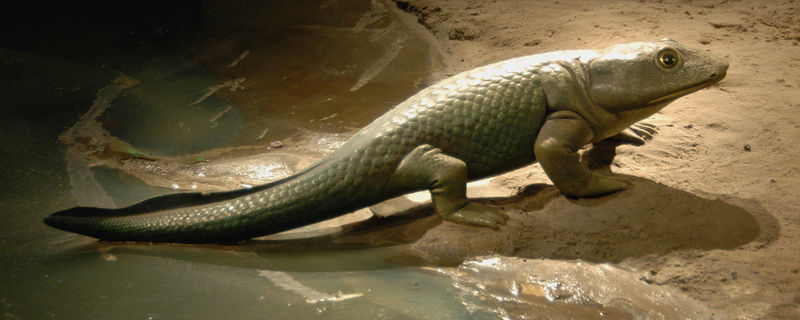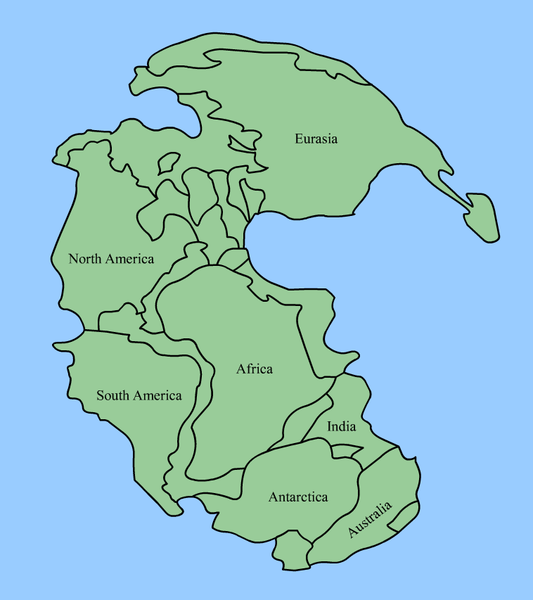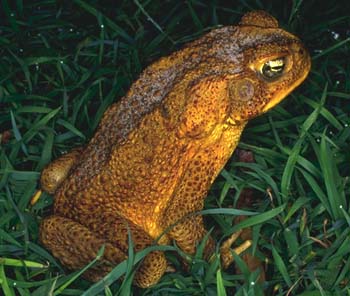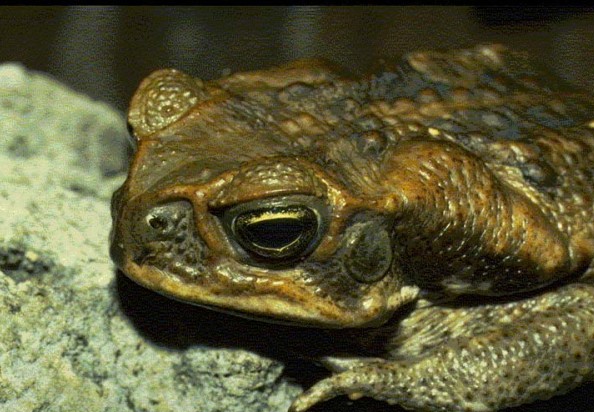The Most-Traveled Cane Toad
Swinging in the tree o' life!
Questions answered (and bookmarked) on this page:
The overview: Scientists classify organisms in
a nested manner, in which groups of organisms are successively
broken down into smaller and more closely related groups.
Cane toads are domain eukarya, kingdom animalia, phylum
chordata, class amphibia, order anura, family bufonidae.
The final categories of classication (genus then species)
are variable for the cane toad, depending on
the author and the age of the the source. The species
was named as Rana marina by Linnaeus in 1758.
Since then, the name has shifted to Bufo strumosus
in 1858, Bufo agua in 1916, Bufo marinis [sic]
also in 1916, Bufo m. marinus in 1966 (as potential
subspecies became apparent), Bufo marinus marinus in
1972, Rhinella marina in 2006, and since then as
Chaunus marinus. Most literature refers
to the species as Bufo marinus, but newer literature has
switched over to Chaunus marinus.
These are all sub-classifications within the genus Bufo;
Chaunus is a further subclassification of Rhinella.
Linnaeus in 1758.
Since then, the name has shifted to Bufo strumosus
in 1858, Bufo agua in 1916, Bufo marinis [sic]
also in 1916, Bufo m. marinus in 1966 (as potential
subspecies became apparent), Bufo marinus marinus in
1972, Rhinella marina in 2006, and since then as
Chaunus marinus. Most literature refers
to the species as Bufo marinus, but newer literature has
switched over to Chaunus marinus.
These are all sub-classifications within the genus Bufo;
Chaunus is a further subclassification of Rhinella.
-Domain Eukarya (‘true nut, or nucleus’: Eukaryotes have cells containing nuclei and have functions confined to given locations within the cell. Cane toads have 22 chromosomes in the nucleus of cells.
-Kingdom A nimalia (‘living
breaths’): This kingdom, the animals, is composed of
multicellular organisms who do not make their own food but
depend on either plants or other animals.
Animals tend to use sexual reproduction to create genetically
unique offspring. Cane
toads eat both plant and
animal matter, and love their sex lives.
nimalia (‘living
breaths’): This kingdom, the animals, is composed of
multicellular organisms who do not make their own food but
depend on either plants or other animals.
Animals tend to use sexual reproduction to create genetically
unique offspring. Cane
toads eat both plant and
animal matter, and love their sex lives.
 -Phylum chordata (‘cord’, as in nerve
cord): Within kingdom animalia is phylum chordata.
Chordates have a backbone. At some
time in their lives, they have gills and a muscular tail.
Cane toads certainly have a spine, and as tadpoles they
have both gills and a tail.
-Phylum chordata (‘cord’, as in nerve
cord): Within kingdom animalia is phylum chordata.
Chordates have a backbone. At some
time in their lives, they have gills and a muscular tail.
Cane toads certainly have a spine, and as tadpoles they
have both gills and a tail.
-Class amphibian (‘dual lives’):Within
phylum chordata is the class amphibia.
Amphibia has over 4500 known living species.
Amphibians do not intentionally produce body heat (heat may be
generated by movement or metabolism, but body temperature
fluctuates with the environment rather than being maintained at
a set temperature). They have 2 pairs of legs
and a bony jaw and glandular skin lacks hair,
feathers, and scales. They either have lungs
or they had lungs at some point in evolution,
and all have moist skin for cutaneous respiration. 
Amphibians produce vast numbers of offspring. They tend to have a lot of "junk" DNA, but a limited number of chromosomes. Juveniles develop into the distinct adult body by means of a process called metamorphosis. Cane toads bask or hide in shade and seasonally migrate in order to exert some control over their body temperatures. The adult body has 2 pairs of legs. The skin contains huge parotid glands. The toad depends on its lungs both for breathing and for regulating its ability to sink or float in water.
-Order anura (‘without tail’):
Within class amphibia is the order Anura.
These are known as frogs and toads, although all toads are
frogs, and the term “to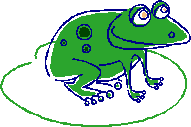 ad” has no phylogenetic (evolutionary
relational) meaning. Anurans demonstrate a
squatting position that results from fused spinal vertebrate in
the postsacral region. Their skulls are fused
to their first vertebrae, which results in a rigid head
position. They have long hindlimbs but rather
short forelimbs, and because
of their pelvic anatomy, can walk, crawl, leap, and swim.
no tail (recall that anura means “no
tail”). [One anuran does have a “tail”, but
it isn’t a muscular tail but an external sexual organ.]
ad” has no phylogenetic (evolutionary
relational) meaning. Anurans demonstrate a
squatting position that results from fused spinal vertebrate in
the postsacral region. Their skulls are fused
to their first vertebrae, which results in a rigid head
position. They have long hindlimbs but rather
short forelimbs, and because
of their pelvic anatomy, can walk, crawl, leap, and swim.
no tail (recall that anura means “no
tail”). [One anuran does have a “tail”, but
it isn’t a muscular tail but an external sexual organ.]
 Males and females are visibly
distinguishable from each other. Anurans were
the first to evolve the ability to vocalize; both sexes have a
larynx, which enables sound production, but the female lacks
vocal sacs which would amplify the sound.
They have large eardrums. They use amplexus
positions for reproduction and have free-standing zygotes
that are not
dependent upon the mother via a placenta.
They have may have
horny tips at the ends of their digits but lack claws.
Males and females are visibly
distinguishable from each other. Anurans were
the first to evolve the ability to vocalize; both sexes have a
larynx, which enables sound production, but the female lacks
vocal sacs which would amplify the sound.
They have large eardrums. They use amplexus
positions for reproduction and have free-standing zygotes
that are not
dependent upon the mother via a placenta.
They have may have
horny tips at the ends of their digits but lack claws.
The cane toad clearly exhibits both the sitting posture and variety of gaits in movement. Cane toads have tails as tadpoles but lack tails in the adult form. [When it is stated that anurans have no tail, we must remember that they are amphibians, and thus exhibit different bodies as they attain sexual maturity.] Males have fewer warts and lack a cream stripe down the back, and all Bufo seasonally exhibit changes in throat coloration between males and females.
-Family Bufonidae (‘tuneful’ or melodious, true toads): Bufonidae are most characteristically distinguished by the presence of the Bidder’s organ in males and the lack of teeth in both sexes. This organ, which is a rudimentary ovary, permits males to transition to sexually viable females. There are 33 genera within family bufonidae and 450 species. Not all have rough skin, and some are aquatic. All have poison glands, although the size, location, toxicity of secretions, and number of glands varies. Families are determined by anatomical features and breeding peculiarities. It takes just one glance at the poison gland of a cane toad to know that it belongs to this family.
-Genus Bufo/Rhinella/Chaunus: Confused over 3 genera? The cane toad is known as Bufo marinus, Rhinella marinus, Rhinella marina, and Rana marina, Bufo marinus, Rhinella marina, and Chaunus marinus. These are in order from oldest to newest and most specific classification. All names refer to the same species but depend upon the manner in which relationships are determined. Rhinella is a sub-genus of Bufo. Bufo marinus is the most commonly accepted name for the cane toad. Members of the genus Bufo tend to experience seasonal breeding, lack parental care for the young, and have horizontal pupils. Genera (plural of genus) Rhinella and subgenera Chaunus are confined to South American species.
-Species marinus/marina (‘marine’, or salty water): The following information is an exact repeat of “Describe the appearance of a cane toad"– but you were warned, so read at your boredom or to refresh your memory. OR, skip repeat.
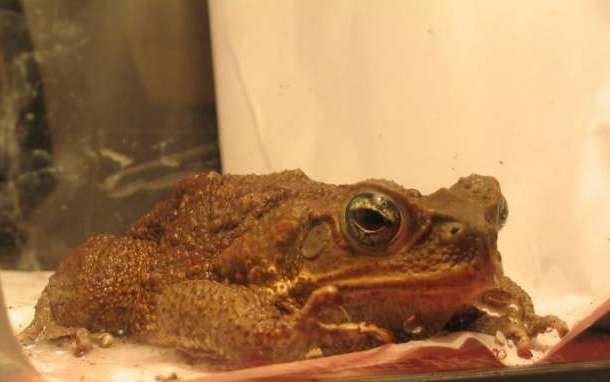 Generally these toads sit
rather erectly and are terrestrial (one pair has been observed
2.5 m up in a tree!). First, consider the
appearance of a cane toad. Cane toad eggs are
black. Cane toad tadpoles are completely
black and between 1 and 2.5 cm in length, with tail length equal
to the body length. New metamorphs are about
10 mm in size and lack large parotid glands.
They have relatively narrow bodies, broad heads with
blunt-snouts and lateral nostrils, and *tend*
to be slightly greenish.
Generally these toads sit
rather erectly and are terrestrial (one pair has been observed
2.5 m up in a tree!). First, consider the
appearance of a cane toad. Cane toad eggs are
black. Cane toad tadpoles are completely
black and between 1 and 2.5 cm in length, with tail length equal
to the body length. New metamorphs are about
10 mm in size and lack large parotid glands.
They have relatively narrow bodies, broad heads with
blunt-snouts and lateral nostrils, and *tend*
to be slightly greenish.
Both metamorphs
and adults have unwebbed fingers on the
front feet and moderately
webbed toes and callouses on the back feet, light colored
bellies, horizontal pupils, and have many warts on their backs.
Warts on the legs are smaller than warts on the back.
In males, each wart has at least one spike protruding
from it. There is a large ridge above the eye
and often a less prominent, more incomplete ridge below the eye.
The ridge under the eye runs to the tip of the eye and
then along the side of the flat portion of the skull towards the
snout, where it merges with the ridge from the other eye
Behind and slightly below the eye is the tympanic membrane (external appearance of the internal ear), which presents as being slightly large than half the size of the eye and light in color. Adults tend to lose the greenish tinge, instead being shades along the continuum of red, brown, and black. After 5 cm, cane toad adults have a 4:3 length to width ratio. For example, a toad might be roughly 6 inches long by 4.5 inches wide. Their bodies are relatively flat.
About 360 million years ago, the first
tetrapod (four-legged creature) arose from a fish with
reinforced fins that could bear weight. The
fish propelled its body by means of these evolving legs, using
its tail not for locomotion -as do
most fish- but for
balance. This fish was likely an Ichthyostega
(image below), whose fossils suggest that it may have
occurred around
Ichthyosteaga. Pangaea.
As vascular plants evolved to form forests, these primitive amphibians spread across the mega-continent of Pangaea, from which all current-day continents split. This tetrapod spread took 135 million years. Alternatively, because of the wide distribution of both Ichthyostega and other lobbed fish, amphibians may have evolved from different groups in different locations. Regardless, as new habitats were encountered, tetrapods continued to diverge. A group known as Labyrinthodonts arose. These evolved the amphibian auditory ossicle, a broadened skull structure, and exhibited an ossified skeleton upon sexual maturation -- which sounds sort of like metamorphosis. 250 million years ago, climatic change cooled the planet, and seasonal weather changes dictated not only hibernation, but narrowed the seasonal time frame for which adult reproduction result in successful offspring: offspring needed enough time to mature before the next seasonal hibernation.
Skeletal changes occurred.
Over time some tetrapods evolved a more light weight
skeleton, forming a theorized creature known as Lissamphibia.
Lissamphibia is hypothesized to have occurred during a 30
million year period from which no fossils have been discovered.
However, from this predicted ancestor arose Batrachia,
which split to form Salienta . Fossils of this animal have been
found in

Note that evolution from Ichthyostega to Anura is based on fossil evidence. Within Anura, various DNA analysis has been used to discern relationships. Within Rhinella, relationships are derived from mitochondrial DNA.
Below are some picture of other C. marinus group members. Scroll over the photos to see the identity of each!
If you skipped Toadily Habits to read this stuff, please treat yourself now! Quite fun! Toadily Habits.
Or if you're boring, go Home.

